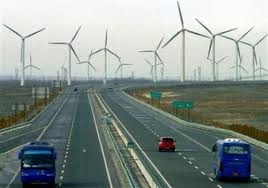China
Jiangxi province to impose higher charges on energy-guzzlers
The local government of China's Jiangxi province will be charging higher electricity prices on energy guzzlers, amid a national drive for energy-saving and energy efficiency.
Jiangxi province to impose higher charges on energy-guzzlers
The local government of China's Jiangxi province will be charging higher electricity prices on energy guzzlers, amid a national drive for energy-saving and energy efficiency.
China's Huadian to use 200MW turbines from Spain's Gamesa
Spanish wind turbine maker Gamesa has signed a deal to sell and install 200 megawatts of wind turbines for China's Huadian New Energy Development by 2012, according to Reuters.
Lack of financing slow down Chinese module manufacturing: Jeffries
Tier 1 & 2 of China-based module manufacturers were running at ~50% utilization rates due to overcapacity and weak demand, according to the investor note of Jeffries equity analyst Jesse Pichel.
JinkoSolar wins module supply contract for new Chinese PV systems
JinkoSolar has been solely awarded the module supply contract for China Guangdong Nuclear Solar Energy Development's upcoming projects in Dunhuang and Qinghe County.
Chinese and Brazilians firms join hands in developing renewable energy
Brazilian utility Furnas has signed an accord with China Three Gorges Corporation to develop renewable energy projects around the world.
CWPI starts building 198MW Chinese wind farm
Construction on the 198MW phase III wind energy development project in Heilongjiang Province, China has been started by China Wind Power International.
India, China to exhibit growth in nuclear energy: IAEA
The International Atomic Energy Agency feels that the global atomic sector would largely be driven by countries like India and China.
Delong completes 15MW co-generation power plant in Hebei, China
The power plant reduces the Group’s total coal usage by about 36,000 tons, saving the company an estimated RMB 40m a year.
GE partners with AB InBev for water and energy efficiency initiatives in China
AB InBev targets to decrease CO2 output and reduce the water-to-beer ratio to 3.5 by 2012.
China’s Changshu new power plant units set to be automated
The two new units which will support China’s Yangtze Delta area are expected to come online in February 2012 and August 2012.
China orders closure of Jinko Solar manufacturing facility
Chinese officials have ordered the closure of a Jinko Solar solar panel manufacturing plant in the Zhejiang province of China, over fears of flouride pollution. The move comes after local residents staged violent protests, accusing the plant of polluting the nearby river and killing large numbers of fish. Haining environmental protection bureau head Chen Hongming told Xinhua that the factory's waste disposal system has been failing pollution tests since April. Officials have ordered the company to stop production, and overhaul the production procedures that involve emission of waste gas and wastewater.
CEC: China may encounter a wider power shortfall
China is predicted to face a widening power gap in the years to come, which may be worse than the situation at the end of the 11th Five-Year Plan period from 2006 to 2010.
Myanmar hydroelectric project to proceed amid objections
Myanmar will go ahead with construction of a major dam along its main river despite opposition from ethnic minorities and environmentalists.
The market for smart grid rollout in Asia-Pacific
Rocketing demands for power across the Asia-Pacific has fuelled a growing market for smart grid technology. Energy providers in countries like China, Japan and India have raised the need to introduce efficient ways to generate electricity, but a cautious approach left the region lagging behind the US and Europe. The smart grid market in the Asia Pacific (APAC) region has emerged slowly over the past few years; increased consumption of electricity in countries like China, Japan and India has raised the need to introduce alternative measures to generate or to save electricity. The development of smart grids has therefore picked up steam in several countries such as Australia, New Zealand, China, Singapore, South Korea and India. The smart grid market and its enabling technologies are emerging slowly in the APAC region. The initiative to roll out smart meters was first undertaken by the Australian market, and New Zealand is currently in the growth stage of rolling out smart metering on its grid infrastructure. China also initiated the process of smart grid development from 2007 under the guidance of the Joint US China Cooperation for Clean Energy (JUCCCE). Although, the smart grid market has began to take shape in Asia Pacific region it still does not compare with smart grid markets in North America and Europe. The slow growth of the activities in APAC related to smart grids can be attributed to the cautious approach taken by governments to incorporate smart grid technologies into their systems. Leading the pumped hydro market "The smart grid market in the Asia Pacific (APAC) region has emerged slowly over the past few years." The pumped hydro market and super capacitor market constitutes the APAC energy storage market for the smart grid. The APAC region is the global market leader in the pumped hydro market. The deployment of smart grids will boost the market for advanced energy storage systems in the APAC region. The market for broadband over power lines (BPL) is yet to take off in a big way in the Asian mainland. However, the outcome of a number of projects initiated in India, South Korea and Indonesia will determine the viability of rolling out the technology on a larger scale. There is huge potential for high voltage direct current (HVDC) in APAC. A number of HVDC projects have already been undertaken during the period from 1965 to 2008 and there are more upcoming projects that will be implemented in the near future. The APAC market for renewable power generation systems related to smart grids is mainly composed of solar and wind energy markets. Renewable incentives for smart rollout The APAC wind energy market was the third largest in the world until 2008 and was concentrated in the markets of New Zealand, Australia, Japan and China. Signs of growth in the solar photo voltaic (PV) sector can also be seen in the region. Therefore, renewable power generation markets in the APAC region provide significant growth potential to the main players in this sector. Key driving factors for implementing smart grid technologies in the current grid infrastructure could be integrating low carbon technologies, reducing power transmission and distribution (T&D) loss, reducing risk of outages, optimising consumption of electricity, incorporating renewables and so on. "The deployment of smart grids will boost the market for advanced energy storage systems in the APAC region." There has also been a significant increase in greenhouse gas (GHG) emissions in the APAC region in the recent years. Apart from transportation, the GHG emitted from the traditional coal fired power plants can be a serious threat to the environment in the long run. Therefore, reducing carbon emissions is a major factor for smart grid deployments in the APAC region. The use of HVDC in the present grid will help reduce the loss of power in T&D significantly. The smart grid will employ a mix of renewable and non-renewable resources, thus decreasing consumption and dependence on fossil fuels imported from oil-producing nations to meet their energy needs. Smart grid projects in Asia Pacific A number of smart grid pilot projects have been witnessed in APAC region in the recent years. These projects are aimed to improve energy efficiency and reduce global warming. The smart grid technology will help to modernise and improve the efficiency of the legacy power grid infrastructure in APAC nations. The use of renewable sources in the smart grid will be much higher with the deployment of advanced storage systems. Two way communication between consumers and utilities will form the backbone of smart grids, enabling reduction in peak demand an reducing consumption of electricity overall. Optimising operation of the current grid assets and active participation of customers are some of the characteristics of the smart grid that are unavailable in the traditional grid infrastructure. Apart from this, smart grids bring numerous other benefits to both the utility provider as well as the end user, like effective management of power consumption, reduction in operation and maintenance cost, cost saving from reducing peak loads etc. However, challenges such as high cost of capital, policy and regulation barriers and consumer unawareness are some of the deterring factors acting as barriers against the growth of smart grid technology in APAC countries. Policies and standards for smart grids in the APAC region are yet to be developed but they do have policies related to increasing the efficiency of the power grid. The smart grid related policies and programmes have been undertaken by some of the APAC nations such as Australia, China and India. Settling on smart grid standards "A number of smart grid pilot projects have been witnessed in APAC region in the recent years." Standards are required for ensuring the interoperability between the different elements of the grid and between the same products from different manufacturers. A few of the smart grid related standards are ANSI C12.19, C12.22, IEEE1547, ZigBee and IEC 61850. The standards for smart grid technology in the APAC region are yet to be established. In terms of competitive landscape, APAC smart grid industry is marked by the presence of global players with prior expertise in smart grids and its related technologies. Major players in APAC smart grid market include ABB LTD, ALSTOM, American Superconductors, Itron, Siemens AG, Telvent and Landis+Gyr. Smart metering in the smart grid industry consists of global players like Itron Inc. and Landis+Gyr, while the HVDC industry consists of players such as ABB Ltd and Siemens AG. The financial activities related to this sector are limited to major players. The lack of local companies has reduced the degree of competition for smart grid segments. However, there have been proposed smart grid investments in some of the regions of the APAC, such as South Korea, India, Sri Lanka, Bangladesh, China and Australia. It has been noticed that the cautious approach taken by the smart grid companies in the Asia-Pacific region is due to the absence of an immediate market, thus limiting growth of smart infrastructure in the region.
CPI to help transport electricity, coal from Xinjiang to east China
CPI will transport gas, coal and electricity from Xinjiang to east China and develop clean energies in Xinjiang as its central strategy.
Inner Mongolia approves CPI's polysilicon, and solar grade silicon projects
The government of Inner Mongolia approved the 6000-ton polysilicon and 800MW solar grade silicon sheet project undertaken by CPI Mengdong Energy Group.
Unit 2 of Liangcun cogeneration plant passes 168-hour test run
Unit 2 of Liangcun Cogeneration Plant of China Power Investment Hebei passed the 168-hour test run with an average unit load of 102.15%.









 Advertise
Advertise


















